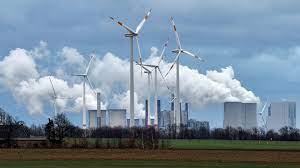EU’s greenhouse gas emissions dropped last year, but accelerated efforts still needed to meet ambitious 2030 targets

Brussels: Greenhouse gas emissions dropped by two percent last year across the European Union, compared to 2021 levels according to estimates in the latest European Environment Agency (EEA) ‘Trends and Projections’ report published here.
However, despite gains made in emissions reductions, renewable energy and energy efficiency, the report cautions that accelerated action is urgently needed to meet the EU’s ambitious climate and energy targets.
Now that the bulk of EU climate and energy legislation under the ‘Fit for 55 package’ is in place, the EU and its Member States are working to deliver on the targets, according to Trends and projections in Europe 2023 report which details progress made.
As greenhouse gas emissions returned to a downward trajectory following the 2021 rebound from the Covid-19 pandemic, Member States also reported a higher level of ambition for 2030 reductions and thousands of national policies and measures to deliver on climate and energy objectives. While the report highlights some encouraging signs of progress, it also emphasises that efforts will need to at least double to reach the ambitious targets set for the end of this decade.
The EU has reduced net greenhouse gas emissions including international aviation, by 31% compared to 1990 levels, while simultaneously fostering economic growth. Against the backdrop of soaring natural gas prices, 2022 witnessed a 2% reduction in greenhouse gas emissions, driven by substantial decreases in the buildings and industrial sectors, while emissions from energy supply and transport saw an increase.
To achieve the 2030 emission reduction target, the pace of annual greenhouse gas emission reductions in Europe must more than double compared with the annual progress seen since 2005, the EEA report says. More rapid reductions are particularly needed for the emissions from road transport, buildings, agriculture, waste and small industries, all of which are covered under the Effort Sharing Regulation. Reductions in energy consumption and growth of renewable energy must accelerate even faster to reach the 2030 targets as included in the recently adopted Energy Efficiency and Renewable Energy Directives.
At the same time, the report indicates noticeable progress in specific areas. While wind and solar held a modest presence in the 2005 electricity sector, their estimated share in electricity production has surpassed 20% in 2022. The recent roll-out of solar deployment was particularly remarkable as it grew by 28% over the course of 2022. The report also notes a remarkable surge in the sales of heat pumps during 2022 and the increasing share of electric vehicles, accounting for a 22% share in the total new car sales last year.
In March 2023, Member States reported more than 3000 policies and measures to achieve the energy and climate objectives. They project that measures already in place across Europe would lead to a reduction of 43% in 2030 for total net greenhouse gas emissions including international aviation, while further measures that are currently being planned would boost reductions to 48%. Last year, Member States only projected this reduction to total 41%, indicating a joint increase in ambition across Europe in the past year. However, this will still leave a seven percentage point gap to the 55% EU climate 2030 target.
Looking beyond 2030, the gap between the projected effect of policies and measures and the targets is wider, the EEA report says. It cautions that the window of opportunity to put in place the right decisions and technologies is limited, making it imperative that climate neutrality is taken into account in policies that address many sectors. In particular, the report highlights that there is an urgent need to speed up efforts in transportation and agriculture towards 2050, which have so far lagged other sectors in reducing emissions and mentions the crucial contribution of increasing the CO2-removal capacity within Land Use, Land-Use Change and Forestry sector.
The update of Member States’ National Energy and Climate Plans (NECPs), with drafts being submitted since the summer of 2023, and final updated NECPs to be expected by 30 June 2024, provides an opportunity for Member States to establish stronger policies and measures and enhance ambition levels. The report says that the update of these plans, together with the rapid implementation of measures adopted at EU level, are key ingredients to deliver on the targets.
The EEA is at the same time launching its Status of reported national adaptation actions in 2023 briefing which presents the current state of play of national adaptation policies. Both are being released at the same time under the EU’s Climate Law Progress Assessment which looks at both mitigation and adaptation efforts across EU Member States.





